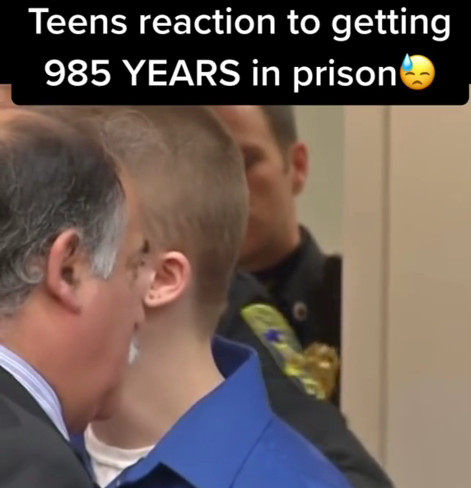985 YEARS FOR A TEEN: A CASE THAT COULD REDEFINE JUVENILE JUSTICE
As the judge delivered the words, the teenager sat frozen, struggling to process the reality of his fate. The weight of the sentence was palpable, felt by everyone present—from legal professionals to onlookers whose eyes remained fixed on the unfolding scene.
A Sentence That Shook the Courtroom
The case followed a long, high-profile trial involving multiple violent offenses that had rattled the local community. Charges ranged from armed robbery to assault, painting a portrait of a life already caught in a destructive cycle.
Prosecutors argued that such serious crimes demanded an equally serious punishment—not just to hold the teen accountable, but to send a warning to others. The defense countered, emphasizing his age and arguing that the sentence stripped away any chance for redemption. The clash of perspectives brought to light a deep moral dilemma: How should society treat young people who commit violent acts?
Inside the Courtroom: From Defiance to Shock
When the sentence was finally read aloud, witnesses described a visible change in the teen’s demeanor—his earlier defiance replaced by disbelief and devastation. Sitting among lawyers and officers, he appeared small against the sheer scale of his punishment.
Cameras captured every second, and the footage quickly spread online, fueling intense public debate. The stark image of a young man facing a sentence longer than multiple lifetimes became a symbol for the deeper flaws and divisions within the justice system.
Public Reaction: Justice or Injustice?
The country split into two camps. Supporters of the verdict argued that it sent a clear message: age should not excuse violent crime, and extreme punishment deters future offenders.
Critics, however, pointed to the reality that teenagers are still developing mentally and emotionally. They argued that justice should include the possibility of change, and that denying it only perpetuates cycles of failure and hopelessness. The discussion spilled into newsrooms, online forums, and social media feeds, showing just how emotionally charged the case had become.
Rehabilitation vs. Retribution
Programs offering education, vocational training, therapy, and mentorship have proven successful in reducing repeat offenses. Supporters believe these initiatives can transform troubled youth into contributing members of society—benefiting both individuals and communities.
Justice Beyond Punishment
This case has also highlighted the deeper societal problems that contribute to youth crime, such as poverty, inadequate education, and living in environments where violence is normal. Addressing these root causes, critics argue, is just as important as enforcing the law.
Without tackling the conditions that push young people toward crime, even the harshest sentences may do little to prevent future offenses.
The Crossroads of Change
The sentencing of a teenager to 985 years in prison is more than a court decision—it’s a moment that forces society to ask difficult questions. Can justice be fair if it leaves no room for growth or redemption? Can we protect communities without writing off an entire life?
